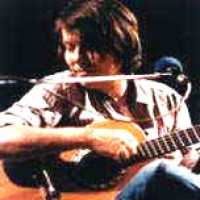Fabrizio De André was born in Genoa on 18 February 1940. His father, an anti-fascist who had taken refuge in the Asti area during the war, had gone back to Genoa with his family in 1945. There, Fabrizio went through primary, middle and high school, and developed a penchant for poetry, music and theatre, getting to know other future celebrities including Luigi Tenco, Bruno Lauzi, Paolo Villaggio and the producer Aldo Trionfo. He enrolled to study Law at University, but at the same time played the guitar and violin at jazz and folk concerts and penned his first ballads, inspired by George Brassens and Medieval troubadour music. This musical calling inevitably drew him away from his future career as a lawyer, and eventually he abandoned his degree. His first record (now forgotten) was released in 1958, and was followed by several other singles. However, his major artistic break was to come several years later when Mina's recording of his "La canzone di Marinella" became a huge hit. He recently chose to commemorate this event by dedicating the album "Mi Innamoravo di Tutto" to her. "If Canzone di Marinella hadn't been sung by such a miraculous voice", he said, "I would probably have finished my law degree and spent my life as a lawyer. I wish to thank Mina for having given me this opportunity..." And so his career as a full-time musician really took off in the late 1960s. In 1962 he married a local Genoa girl called Enrica, who gave him his first son, Cristiano (who followed in his father's footsteps to become a singer-songwriter and has played with him in concerts and on the album "Anime Salve"). In 1965 his first collection of ballads was released on an LP. However, 1967 and 68, the years of the student demonstrations, marked a turning point in his career. The Belldisc label published his album "Fabrizio De André Volume I", which contains most of his songs that have now become classics. This was followed by "Tutti morimmo a stento" and Volume II, records which achieved almost cult status due to the strong emotions of those years. The next few years were enormously successful for him. In 1970, he released "La Buona Novella", freely based on the Apocryphal Gospels, followed in 1971 by "Non al denaro non all'amore né al cielo", a re-interpretation of Edgar Lee Master's famous "Spoon River Anthology". In 1973, he made the album Storia di un Impiegato, which questioned the motives behind the student demonstrations, and the following year he paid tribute to his idols (Brassens, Dylan and Cohen) with the album "Canzoni", interpreting their songs and accompanying them with some of his own songs from the 1960s. 1975 was the year of "Fabrizio De André Vol.7", on which he collaborated with Francesco De Gregori. It was also the year of his first tour. In the meantime, his plan of moving to the island of Sardinia gradually came to fruition. He bought a small estate ,l'Agnata, in the Tempio Pausania area and spent his time farming and raising livestock. Two years later, he had a daughter called Luisa Vittoria with the singer Dori Ghezzi, whom he was later to marry. In 1978 he released the album "Rimini", followed in 1979 by a memorable live double album recorded during his tour with PFM. On 28 August of the same year, the most dramatic event of his life took place when he and Dori Ghezzi were kidnapped by Sardinian bandits. This harrowing four-month experience provided the inspiration for a superbly thought-provoking album on the lives of the Sardinian people, released in 1981. The untitled LP was remembered as "L'indiano". 1984 was another decisive year. Together with the ex-PFM musician, Mauro Pagani, he recorded the album "Crueza de mâ", which music critics hailed as the finest record not only of the year, but even of the whole decade. It was indeed an historic album: completely going against current trends, De André combined a highly poetic use of his native Genoese language with the typical folk sonorities of the Mediterranean tradition. The musical composition and poetical effects were superb and brought out new expressive qualities in the artist's vocal talents. In 1988, he married his companion Dori Ghezzi and in 1989 embarked on a partnership with Ivano Fossati (producing such memorable tracks as "Questi posti davanti al mare"). In 1990 he released "Le nuvole", a huge success in terms of both sales and reviews, and set off on an enormously popular tour. Next came the 1991 live album and a theatre tour in 1992. After this there was a four-year break until 1996, when he returned to the charts with "Anime Salve", yet another track that was very well received by the critics and public alike. In 1997 he released "Mi Innamoravo di Tutto", a compilation of some of his favourite older tracks which were less well understood by the public. He added the original version of the classic "Bocca di Rosa", along with a splendid duet version of "La canzone di Marinella" sung with Mina. During 1998 the theatre tour continued, interrupted in the summer for health reasons. On 11th January 1999 Fabrizio De André died in Milan, struck down by an incurable illness. On 13th January over ten thousand people attended his funeral, which was held in Genoa. 1999 saw the release of the posthumous live album "De André in Concert" (De André in concerto) which included the tracks "Anime Salve" and "La Buona novella" as well as classics never performed in concert such as "Geordie". In 2000, marking the first anniversary of his death, the collection "Da Genova" was released with tracks less known to wider audiences, among which "Girotondo" and "Canzone per l'estate".
Source: http://www.italica.rai.it/eng/principal/topics/bio/deandre.htm
